Looking for cheap ways to heat your pool?
Keep reading, you’ve found them.
Maybe you installed your pool recently and haven’t chosen a pool heater yet. Or maybe you’re just looking for some cost-effective ways to heat your swimming pool. Regardless of your situation, you’ll find plenty of solutions in the next few paragraphs.
In this post, we show you a few cheap ways to heat your pool that’ll keep your wallet much happier during swim season. And who can resist the opportunity to save money and lower their pool heating costs?
So keep reading, and you’ll learn about a few cheap ways to warm up your pool, as well as what causes heat loss and how to prevent it. And the sooner you put these tips into practice, the sooner you’ll start spending less and swimming more.
Related: 11 Ways To Reduce Pool Energy Use By Over 50%
With that said, here are 7 cheap ways to heat your pool. Let the savings begin.
7 Cheap Ways To Heat Your Pool
How To Heat A Swimming Pool For Free
These next five cheap ways to heat your pool use the power of solar energy and heat retention. Aside from their initial purchase cost, these heating methods generate completely FREE heat for your pool.
Related: 7 Things Every Pool Owner Should Know In 2021
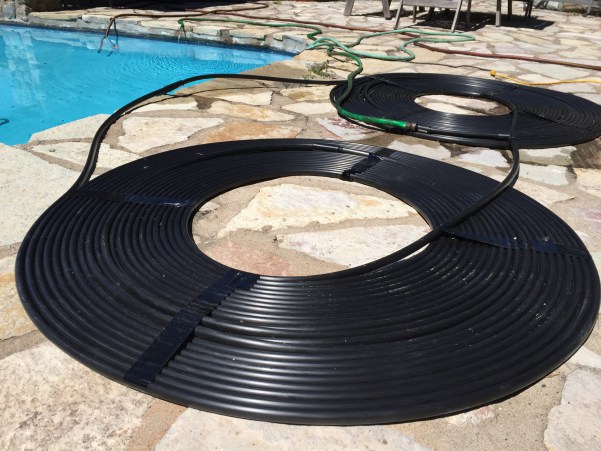


1.) Black hose
This little hack takes advantage of solar energy in a simple, but clever way. Since darker colors absorb the most heat, using a black hose can help warm up your water naturally.
Here’s how to make a DIY solar pool heater with a black garden hose:
- Purchase a black garden hose long enough to travel the distance from your pool pump to an area where it will get direct sunlight. Most pool owners designate a spot on their deck or upon the roofs of their home or backyard shed.
- When placing the hose, make sure you have at least 50 – 100 ft of remaining hose to spare. A total hose length of 150 -300 ft is usually enough to cover this distance.
- Unravel the hose and connect it to your pool pump’s return via a faucet connection (this may have to be installed).
- From there, run the hose to the top of a nearby roof (house or shed), or a spot where it will get the most direct sunlight.
- Wrap the hose in a coil formation as seen in the image above, then run the remaining hose back down, feeding the end of the hose directly into the pool. (The coil formation improves the hose’s ability to retain heat, which means warmer water for you.)
Cost: $80 – $150
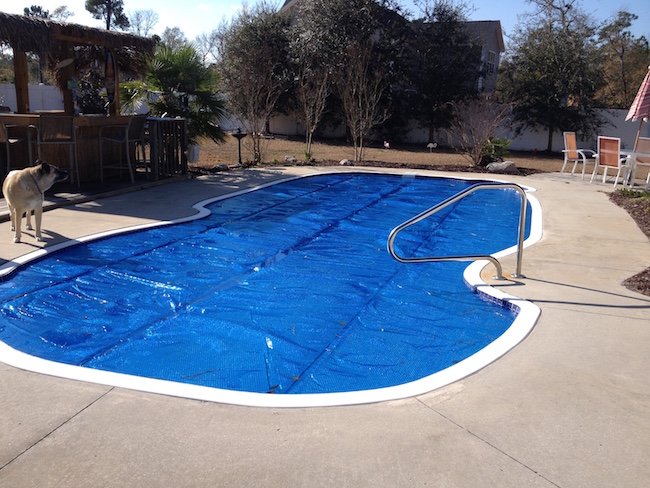


2.) Solar Cover / Pool Cover
Solar covers are one of the most cost-effective methods for retaining heat in a swimming pool.
Why?
Because they tackle the root cause of heat loss head-on:
Evaporation.
Most heat loss occurs during the day, while your water is directly exposed to the elements. From the fierce rays of the sun to the sporadic gusts of wind, each force of nature contributes to your water’s inevitable heat loss.
Natural heat loss that can’t be stopped…unless you use a shield. And what better a shield than a solar cover?
A solar cover not only acts as a protective lid for your pool but is specially designed to absorb solar heat while doing so. This feature gives it the ability to reduce evaporation while improving heat retention.
And with evaporation being responsible for 75% of heat loss, there’s no reason why you shouldn’t take a load off your heating bills with this simple tip.
Cost: $50 – $200
Related: Quick Guide To Swimming Pool Covers | How To Choose The Best One
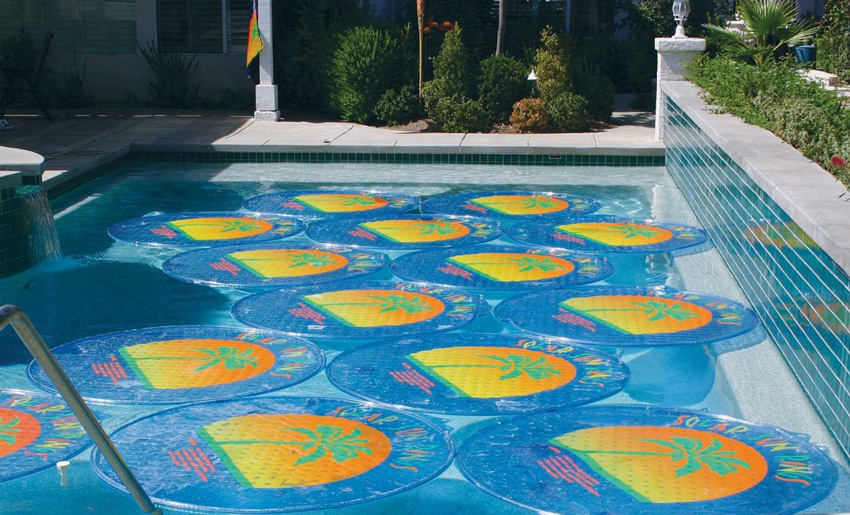


3.) Solar Rings for Pool
If you’re not quite ready to purchase a solar cover, but still want to take advantage of solar-powered heating, then solar rings are an excellent alternative. Think of them as a solar cover broken up into smaller connectable circles, or rings. They’re relatively cheap and easy to use.
Add enough solar rings to the water to cover the surface of your pool. From there, they’ll do the rest, gently floating while locking in solar heat.
Opt for solar rings that contain small magnets inside — these help them stay closer together by magnetically attaching to each other.
Quick Fact: Solar rings can generate up to 21,000 BTUs of heat per day
Cost: $50 – $250
Solar Cover vs Solar Rings | Cost & Convenience
When looking for cheap ways to heat your pool, using anything that takes advantage of solar energy (or heat) is a good place to start.
With that said, between solar covers and solar rings, solar covers are usually the cheaper option. But, a bit more planning goes into purchasing a solar cover, as they need to be fit/cut to your exact swimming pool dimensions.
Solar rings offer a simpler “drop it and go” convenience, where pool owners simply purchase what’s need to cover their water. Of course, the trade-off is that purchasing multiple solar rings typically ends up being more expensive than a single solar cover. So really, it comes down to cost vs convenience.
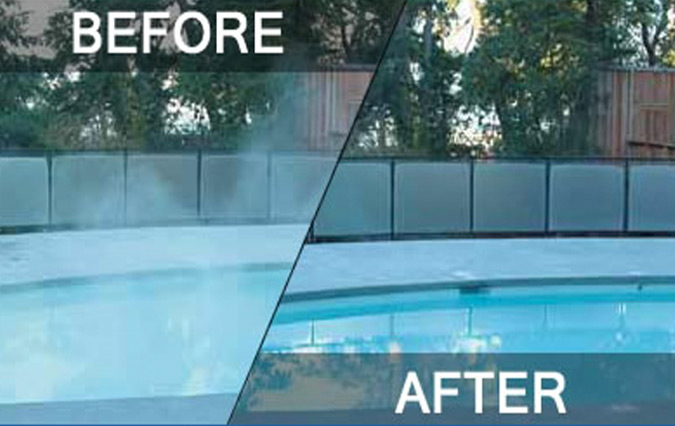

4.) Liquid Solar Cover
Much like regular pool covers, liquid solar covers create a barrier that reduces evaporation. But with liquid solar covers, that barrier is completely invisible to the human eye.
These light-weight solar shields create a thin, eco-safe, and non-toxic chemical barrier that reduces heat loss and improves heat retention. Of course, as revolutionary as liquid solar covers are, they aren’t as effective as traditional covers and rings.
Cost: $20 – $50
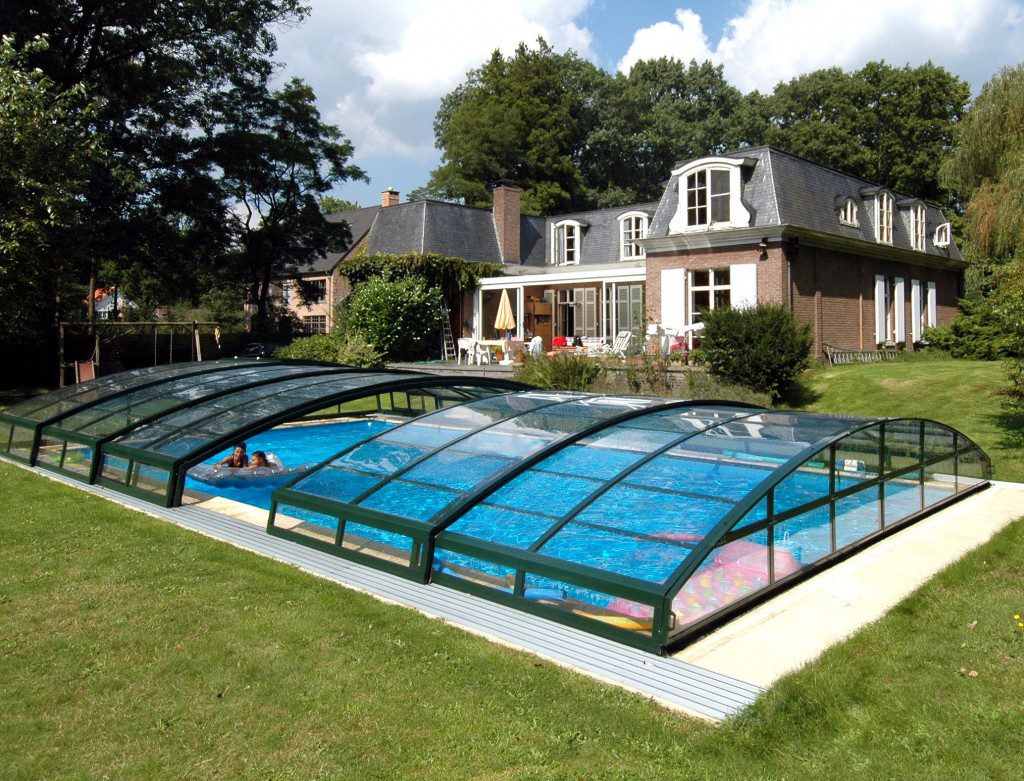

5.) Windproof Pool Enclosure
When you get a cup of cocoa but it’s too hot to drink, what do you usually do?
You take off the lid and blow on it, right? That usually seems to do the trick after a while.
Nearly everyone is familiar with this quick and simple cooling method. But what’s interesting is understanding how the same concept relates to your pool, the wind, and heat loss.
When your water is still and calm, its surface area is proportionate to your pool’s physical size. But when the wind blows, and small waves start rippling across the surface of the water, everything changes. This is because the water’s surface area alters whenever it goes from a still to a moving state.
So that means that even a single gust of wind can affect your pool’s surface area. This is why using a pool enclosure as a barrier is so advantageous. It helps shield your pool against the wind (better heat retention), and at the same time, keeps it cleaner by keeping out debris.
Many pool owners have physical enclosures built around their pools to protect against the elements. It’s an addition that makes pool maintenance easier, and swimming a lot more enjoyable — regardless of weather.
[Learn more: 21 Pool Care Hacks That Make Pool Maintenance Easier]
Cost: Dependent on size of pool deck and material used
Cheap Ways To Heat Your Pool | How To Heat a Pool Fast
If you’re looking for speedier pool heating methods that can still fit your monthly budget, look no further than pool heat pumps and solar pool heaters.
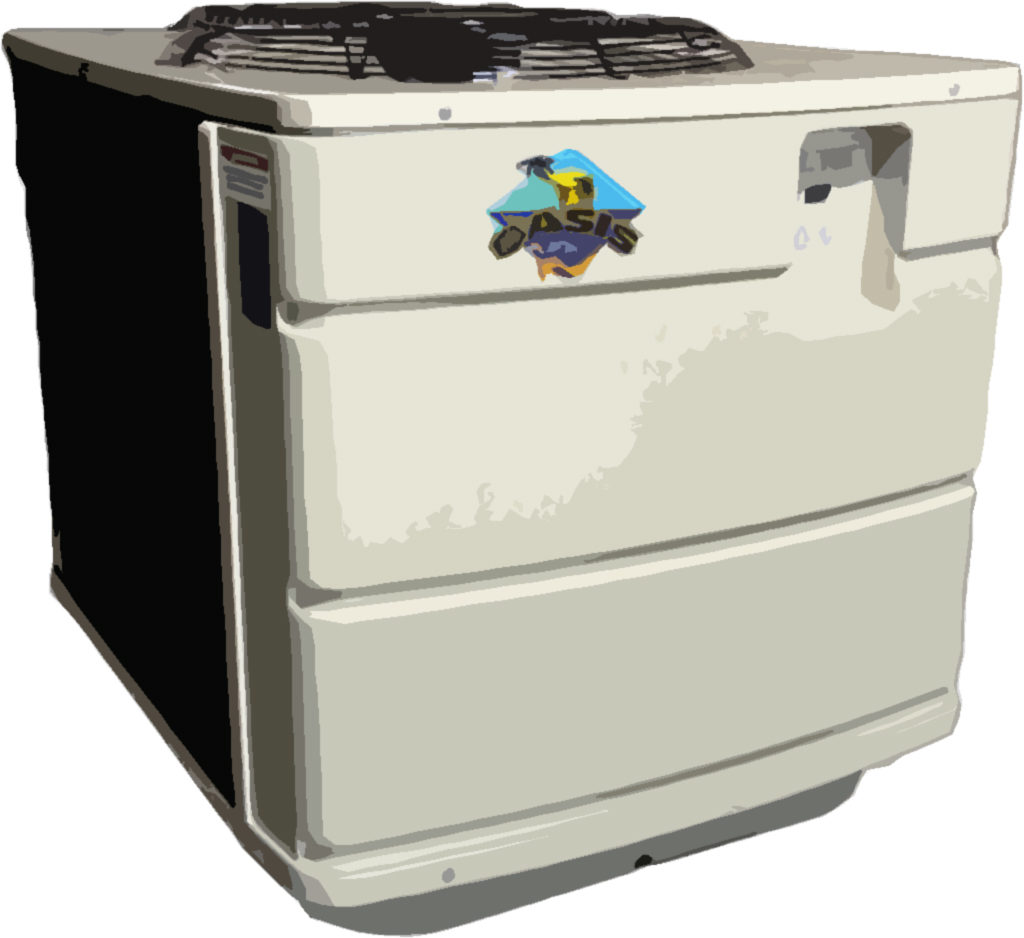

6.) Use a Pool Heat Pump
Instead of using a heating element or gas, pool heat pumps draw in warm air from the atmosphere. Then, they use a low-energy process for magnifying the harvested heat and transferring it to your pool water.
But what’s great about this kind of pool heater is that it produces heat for your pool regardless of the sun. In fact, heat pumps are entirely dependent on temperature as opposed to sunshine.
So, as long as the weather is warm enough (around 40 degrees or higher), pool heat pumps can provide all the heat you need. And they do it much faster than any of the other methods in this post, which makes them great for extending your pool season.
Related: 9 Ways Owning a Pool Heat Pump Improves Your Health & Your Life
Cost: $50 – $150 (monthly)


7.) Use a Solar Heater & Pool Heat Pump together to maximize savings
Of course, there’s one method that can’t be beaten when it comes to cost-effectiveness and performance. And that’s because it involves using two of the most energy-efficient heating solutions available: pool heat pumps and solar pool heaters.
In this scenario, a pool owner uses the pool heat pump to achieve desired temperatures when needed, mainly using the solar heater to sustain the temperature. But what’s great about this combination is that it greatly reduces how often you need to run your heat pump.
Working together, the two heating systems can easily keep the pool warm around the clock. While the pool heat pump covers the cloudy days and nights, the solar heater steps in on sunnier days to maintain the pool heat pump’s hard work.
You can learn more about using these two pool heaters together in this post.
Cost: $25 – $100 (monthly)
Closing Thoughts
So there you have it, 7 cheap ways to heat your pool. As you may have noticed, nearly all of these methods rely on natural heat energy in one form or another — from absorbing and locking in solar energy to harvesting warmth straight from the air.
But of course, the best way to heat your pool is to reduce heat loss. And to do that, just choose a few methods from this post and let nature do the rest.
Have some questions about heating your pool? Talk to a pool heating specialist today
If you liked this post, you might also like:
33 Backyard Inground Pool Ideas For All Budgets
15 Cheap Ways To Upgrade Your Pool
21 Pool Care Hacks That Make Pool Maintenance Easy


